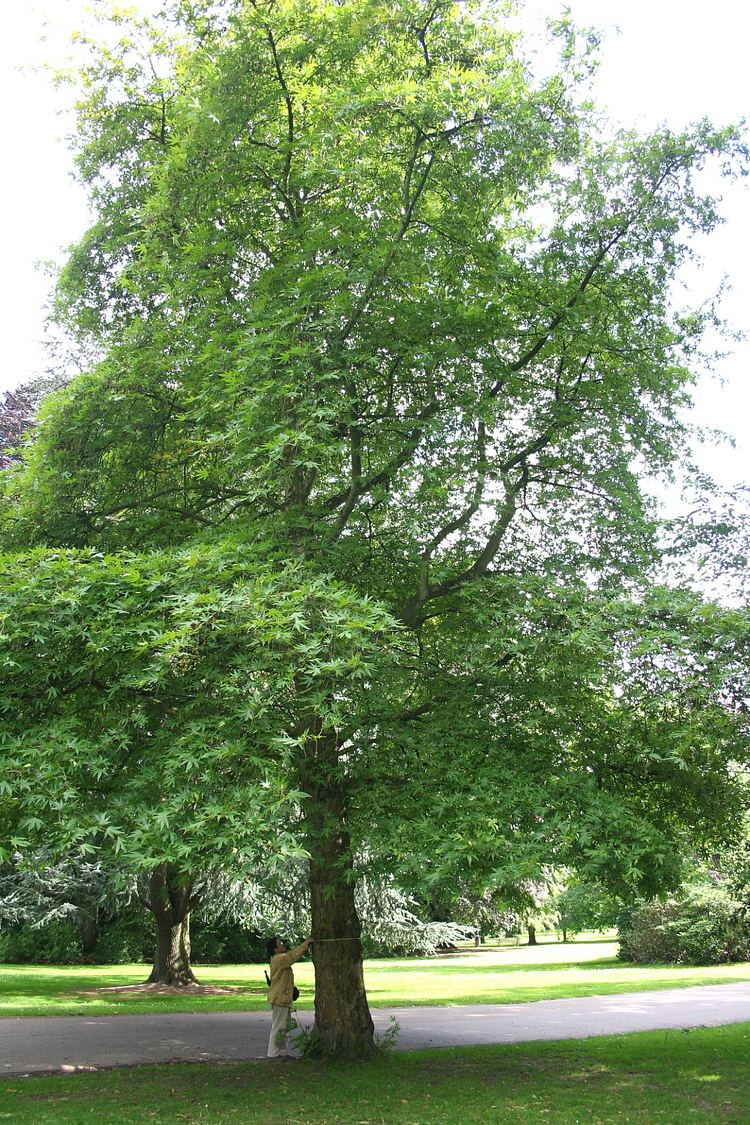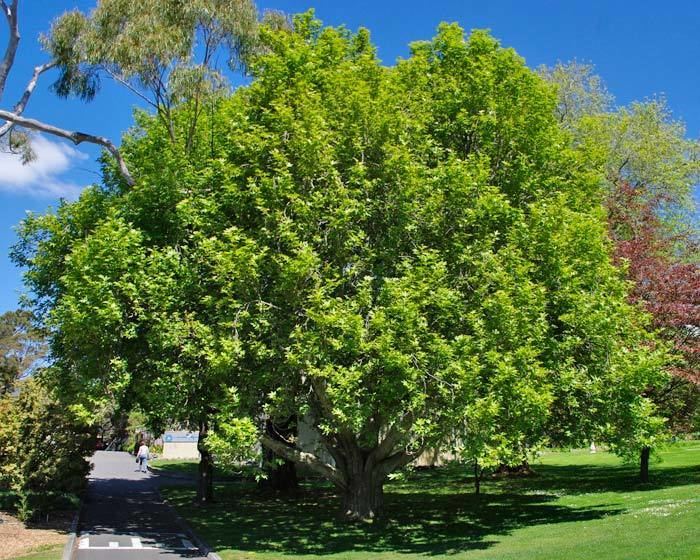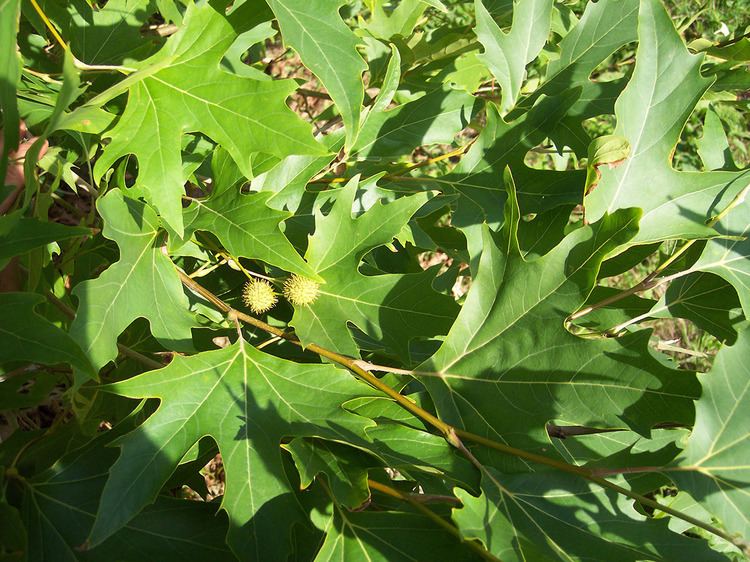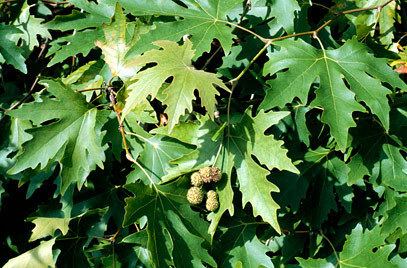Scientific name Platanus orientalis Rank Species | Genus Platanus Higher classification Plane trees | |
 | ||
Similar Styphnolobium japonicum, Plane trees, Weeping willow, London planetree, Koelreuteria elegans | ||
Platanus orientalis in the garden of prepodobna stoyna bulgaria
Platanus orientalis, or oriental plane, is a large, deciduous tree of the Platanaceae family, growing to 30 m (98 ft) or more, and known for its longevity and spreading crown.
Contents
- Platanus orientalis in the garden of prepodobna stoyna bulgaria
- Platanus orientalis digitata cut leaf plane
- Etymology
- Range
- Description
- Cultivation
- Other uses
- Cultural history
- Greece
- Kashmir
- United Kingdom
- References
Platanus orientalis digitata cut leaf plane
Etymology

The species name meaning 'eastern' contrasts it with the western (American) plane, (Platanus occidentalis) and also its original known distribution eastward from the Balkans, where it was recognized in ancient Greek history and literature. Following Greek usage it is called platane or related names in continental Europe. It was equally well known in Asia and from Anatolia (modern Turkey) to India is called chinar, chenar or related names, following the Iranian, except in the Kashmir Valley region. The native Kashmiri word for the tree is boonyi.
Range

The native range is Eurasia from the Balkans to at least as far east as Iran. Some accounts extend its native range to Iberia in the west, and to the Himalayas in the east. As it has been known in cultivation from early times in much of this region it can be difficult to determine if it is truly indigenous in peripheral areas.
Description

The oriental plane is found naturally in riverine settings, together with such trees as alder, willow and poplar. However, it is quite capable of survival and success in dry soils once it is established.

Like other plane trees, its leaves are borne alternately on the stem, deeply lobed, and palmate or maple-like. It usually has flaking bark, occasionally not flaking and becoming thick and rugged. Flowers and fruit are round and burr-like, borne in clusters of between 2 and 6 on a stem. Considerable variation exists among trees in the wild, and this may be complicated by crossbreeding with planted London planes (Platanus x acerifolia), the hybrid of P. orientalis with the American sycamore (Platanus occidentalis).
Cultivation
The tree is capable of being grown in most temperate latitudes, though it benefits greatly from warm summers. As a very large and wide tree with broad, thick leaves that tend to orient horizontally, it is especially prized for the shade and coolness it provides during the hot season.
Other uses
The leaves and bark have been used medicinally. A fabric dye has been made from the twigs and roots. The timber, often called lacewood, is figured and valuable for indoor furniture. The leaves are also often used by artists for leaf carving.
Cultural history
From earliest days, P. orientalis has been an important tree in Persian gardens, which are built around water and shade. There it is known as the chenar.
Greece
The Tree of Hippocrates, under which Hippocrates — the "Father of Medicine" — taught at Kos, is reputed to have been an oriental plane. A 500-year-old tree presently there may be on the same site and may have been planted from a succession of cuttings from the original. The Athenian Academy, outside Athens, featured a sacred grove of planes where the students listened to the masters and where among others the Peripatetics practiced philosophy.
Pliny's Natural History records the westward progress of the plane "introduced among us from a foreign clime for nothing but its shade", planted first at the tomb of Diomedes on the island of Tremiti, then imported to Greek Sicily by Dionysius the Elder(c. 432-367 BC), tyrant of Syracuse. He had plane-trees conveyed to the city of Rhegium (Reggio di Calabria), where they were looked upon as the great marvel of his palace, according to Pliny's sources. From there it spread by the first century CE as far as the lands of the Morini in Belgic Gaul. Regardless of why it may have been introduced, the tree had medicinal uses from early times. Pliny details 25 remedies using preparation from the bark, leaves and excrescences of plane. Pliny prescribes it for burns, bites, stings, frostbite and infections.
Pliny goes on to describe some legendary plane-trees. There was one on the grounds of the Athenian Academy, he says, that had roots 50 feet (15 m) long. Licinius Mucianus held a banquet for 19 in a hollow plane-tree of Lycia, and the emperor Caligula another for 15 plus servants in a tree house (nest) built in the branches of a plane-tree at Velletri.
Most small villages in Greece have one or more very old planes in their central square, where the village water spring used to be (water springs are nowadays replaced by water taps from the same spring captured). Many of them are set in cavities, which are often playing and meeting points for children and teenagers, or are cared for, sometimes even illuminated, as tourist attractions.
Kashmir
In historic Kashmir, the tree was planted near Hindu holy places under names derived from the goddess Bhavani. Later in Muslim times it continued to be a major garden and landscape tree and dominates many historic gardens, now generally called boonyi in local Kashmiri and chinar by Hindi/Urdu speakers. For example, a famous landmark in Srinagar is an island on Dal Lake where four chinar trees stand, named Char Chinar. As another example, a 627-year-old chinar tree has been found at Chatargam, Chadoora, Badgam district, Kashmir. In repute it was planted in 1374 AD by an Islamic mystic, Syed-Abul Qasim Shah Hamdani.
Chinar trees are being felled rapidly in Kashmir, although a recent ban has been enacted to curb cutting. Chinar trees are now required to be registered and are considered State Property. Registered Chinars are painted white at their base. Increased awareness means most old Chinars are protected and looked after; however, some new Chinars must be cut as their growth can cause damage to roads and houses. Chinars are considered as the symbols of the Persian influence on the heritage of Kashmir.
United Kingdom
In 2011 a specimen planted by Capability Brown was identified as the tree with the greatest known spread in the United Kingdom.
